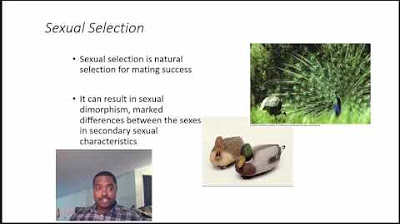Evolution Primer #4 How Does Evolution Really Work Natural Selection
Summary
TLDRThis video explores the process of evolution through natural selection, focusing on hummingbirds as a case study. Biologist Chris Schneider and his team investigate how environmental pressures lead to adaptations in species. Key mechanisms include genetic variation, overproduction of offspring, and the struggle for existence, which drive differential survival and reproduction. The research reveals that bill length in hummingbirds is a crucial trait linked to survival, demonstrating how small changes can accumulate over time. Overall, the findings support Darwin's theory of natural selection as the central force in evolution.
Takeaways
- 😀 Evolution primarily occurs through natural selection, where populations adapt to environmental pressures over time.
- 😀 Researchers in Ecuador study hummingbirds to understand how new species arise, addressing Darwin's fundamental question.
- 😀 Natural selection involves four key processes: genetic variation, overproduction of offspring, struggle for existence, and differential survival and reproduction.
- 😀 Genetic variation allows advantageous traits to be passed on; for example, bill length in hummingbirds is strongly inherited.
- 😀 Hummingbirds produce many offspring, but only a few survive due to competition for resources, leading to natural selection.
- 😀 The struggle for existence drives competition for food, space, and mates, influencing hummingbird adaptations.
- 😀 Small changes in traits, like bill length, can significantly impact survival and feeding efficiency in specific environments.
- 😀 Traits that confer advantages in particular environments will dominate over time, leading to adaptation of the population.
- 😀 Adaptations cannot be acquired within an individual's lifetime; they depend on inherited genetic traits.
- 😀 Recent research supports Darwin's theory, emphasizing that natural selection remains the most crucial mechanism in evolution.
Q & A
What is the primary mechanism of evolution according to the script?
-The primary mechanism of evolution is natural selection, which drives populations to adapt to environmental pressures over time.
What fundamental question did Darwin pose about species?
-Darwin's fundamental question was how new species arise, which the research on hummingbirds seeks to address.
What are the four key processes of natural selection identified in the script?
-The four key processes are genetic variation, overproduction of offspring, struggle for existence, and differential survival and reproduction.
How does genetic variation contribute to natural selection?
-Genetic variation allows individuals within a species to possess different traits, which can confer advantages in survival and reproduction.
Why is overproduction of offspring significant in natural selection?
-Overproduction leads to competition for resources, resulting in a struggle for existence where only some individuals survive and reproduce.
How do hummingbirds exemplify natural selection?
-Hummingbirds demonstrate natural selection through variations in bill length, which affect their ability to access nectar and ultimately their survival and reproduction.
What does the term 'differential survival' mean in the context of evolution?
-Differential survival refers to the idea that individuals with advantageous traits are more likely to survive and reproduce, passing those traits to the next generation.
How does the script explain the adaptation of hummingbirds to their environment?
-Hummingbirds adapt to their environment, such as flower shapes, over time, leading to populations with traits that enhance their feeding efficiency.
What modern tools are used in the research mentioned in the script?
-The researchers use molecular biology and modern computational methods to study hummingbird DNA and reconstruct their evolutionary history.
What is the significance of the last 2 or 3 million years in hummingbird evolution?
-Many hummingbird species are relatively young, having evolved in the last 2 or 3 million years, indicating that evolutionary changes can occur more rapidly than previously thought.
Outlines

This section is available to paid users only. Please upgrade to access this part.
Upgrade NowMindmap

This section is available to paid users only. Please upgrade to access this part.
Upgrade NowKeywords

This section is available to paid users only. Please upgrade to access this part.
Upgrade NowHighlights

This section is available to paid users only. Please upgrade to access this part.
Upgrade NowTranscripts

This section is available to paid users only. Please upgrade to access this part.
Upgrade NowBrowse More Related Video
5.0 / 5 (0 votes)





